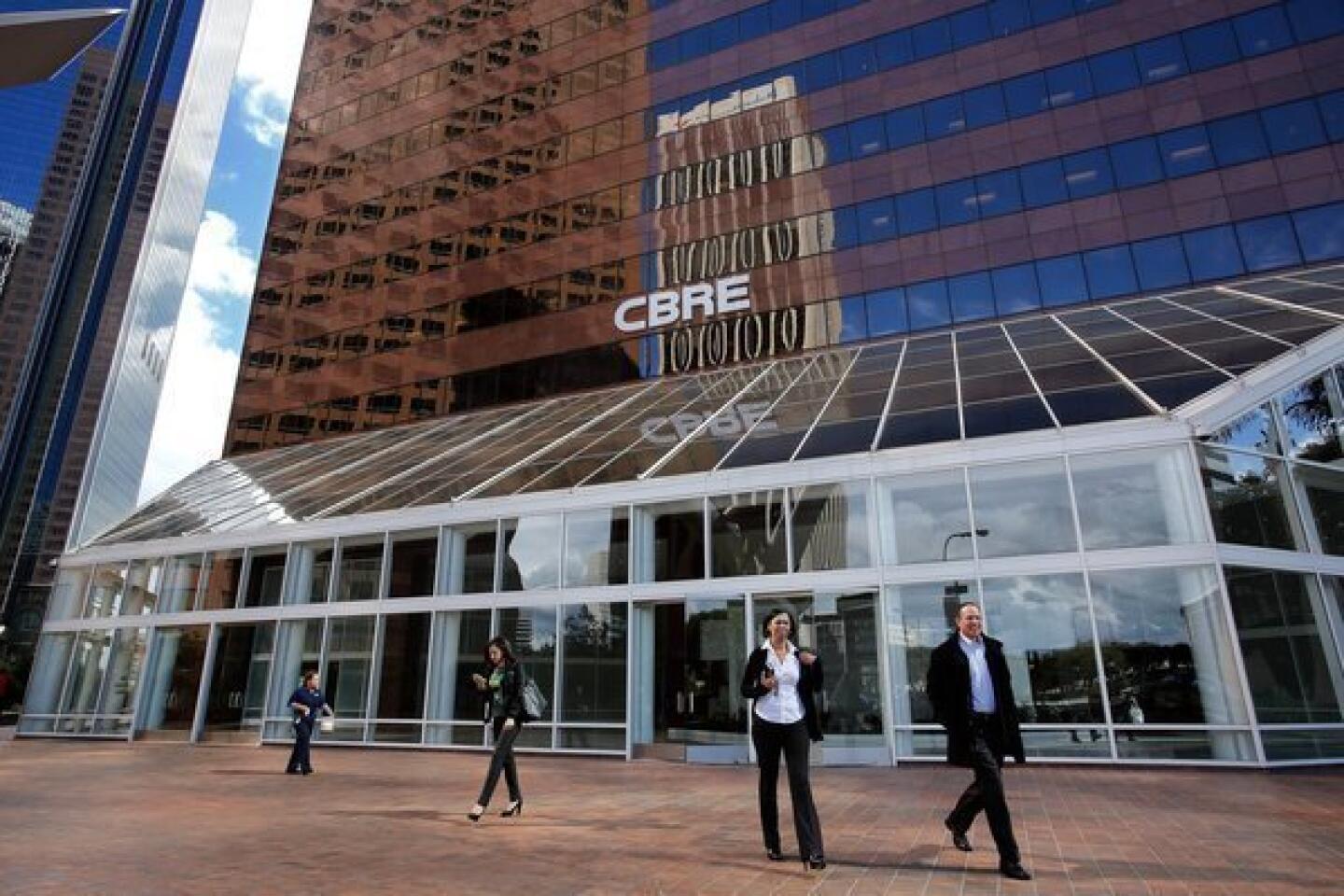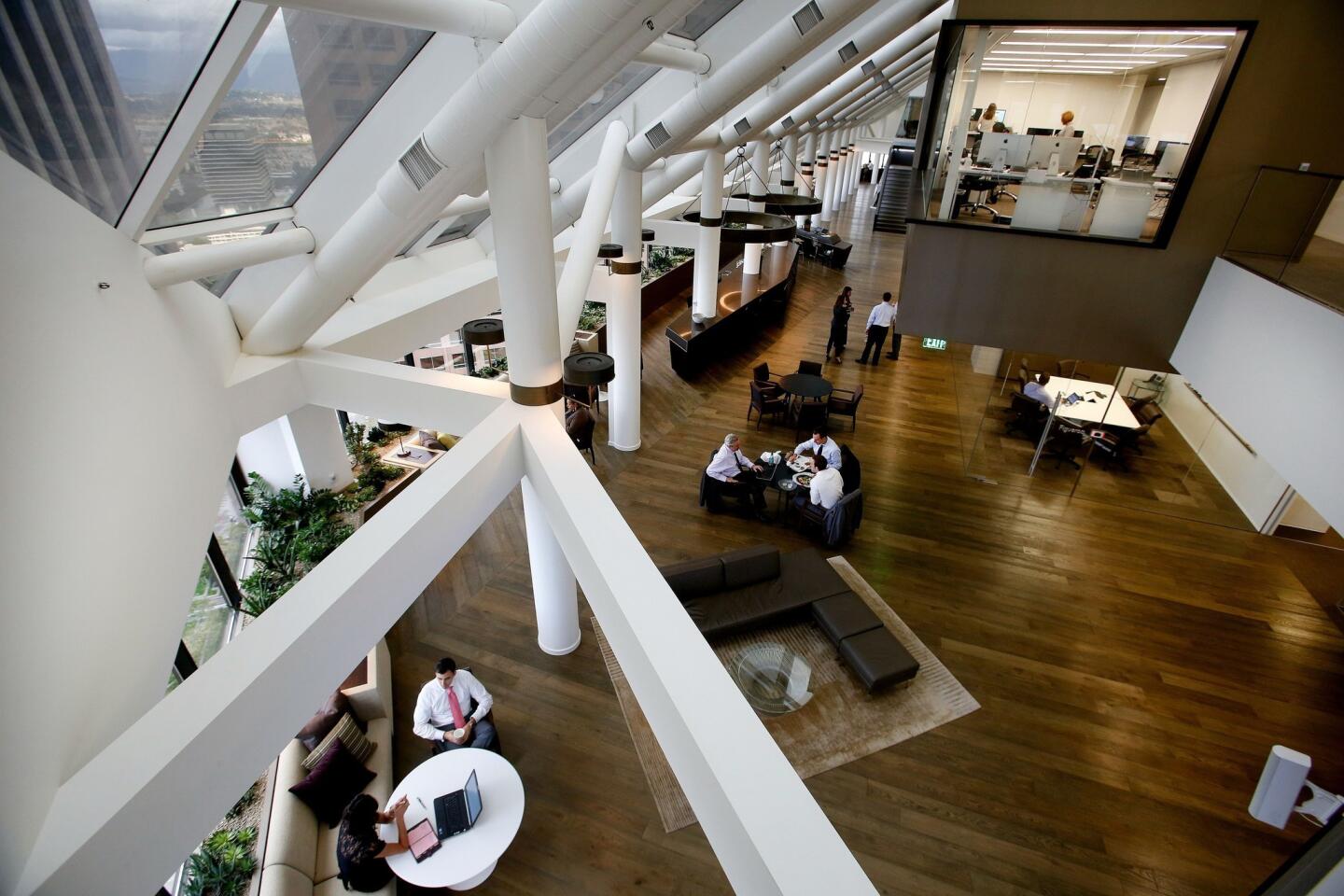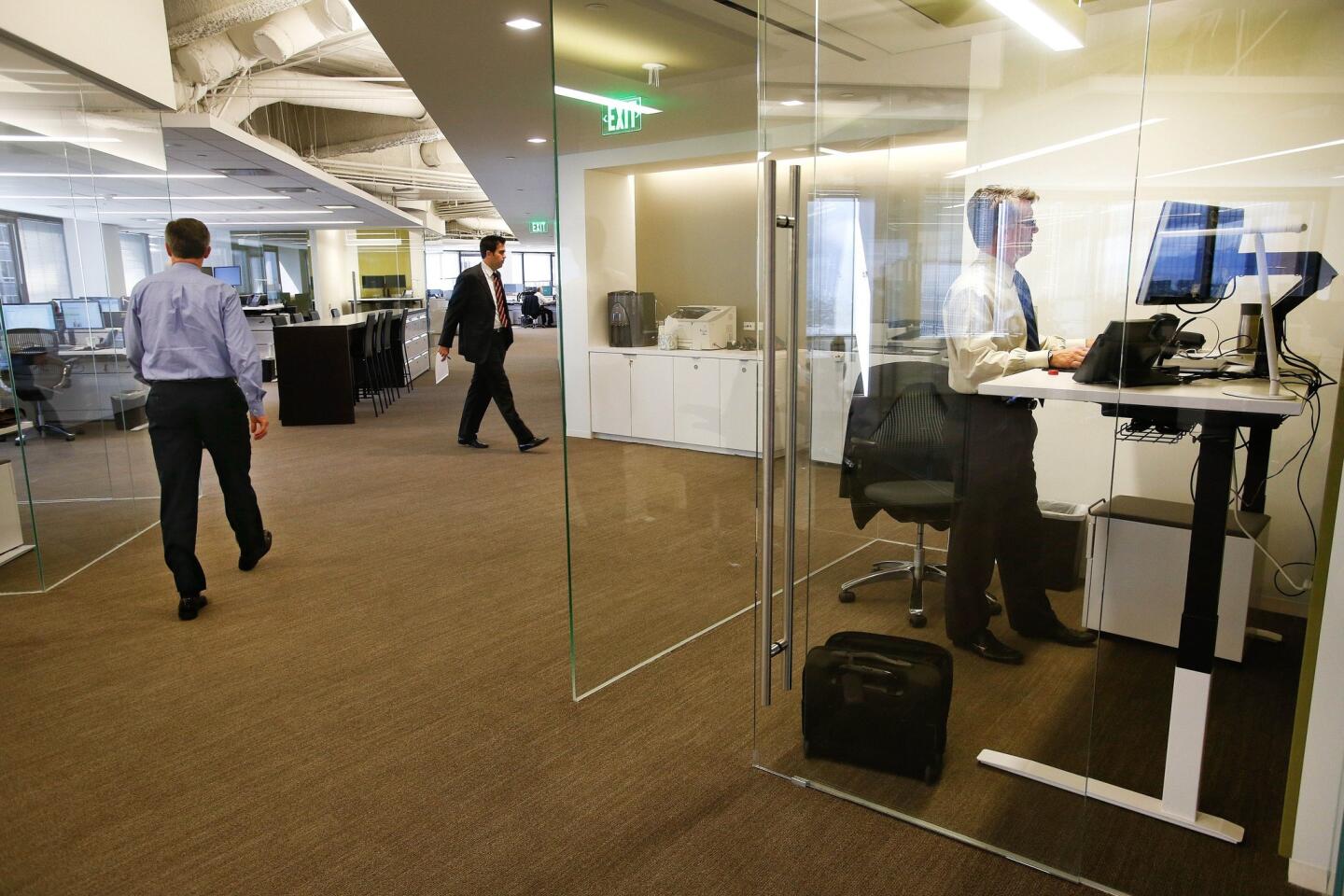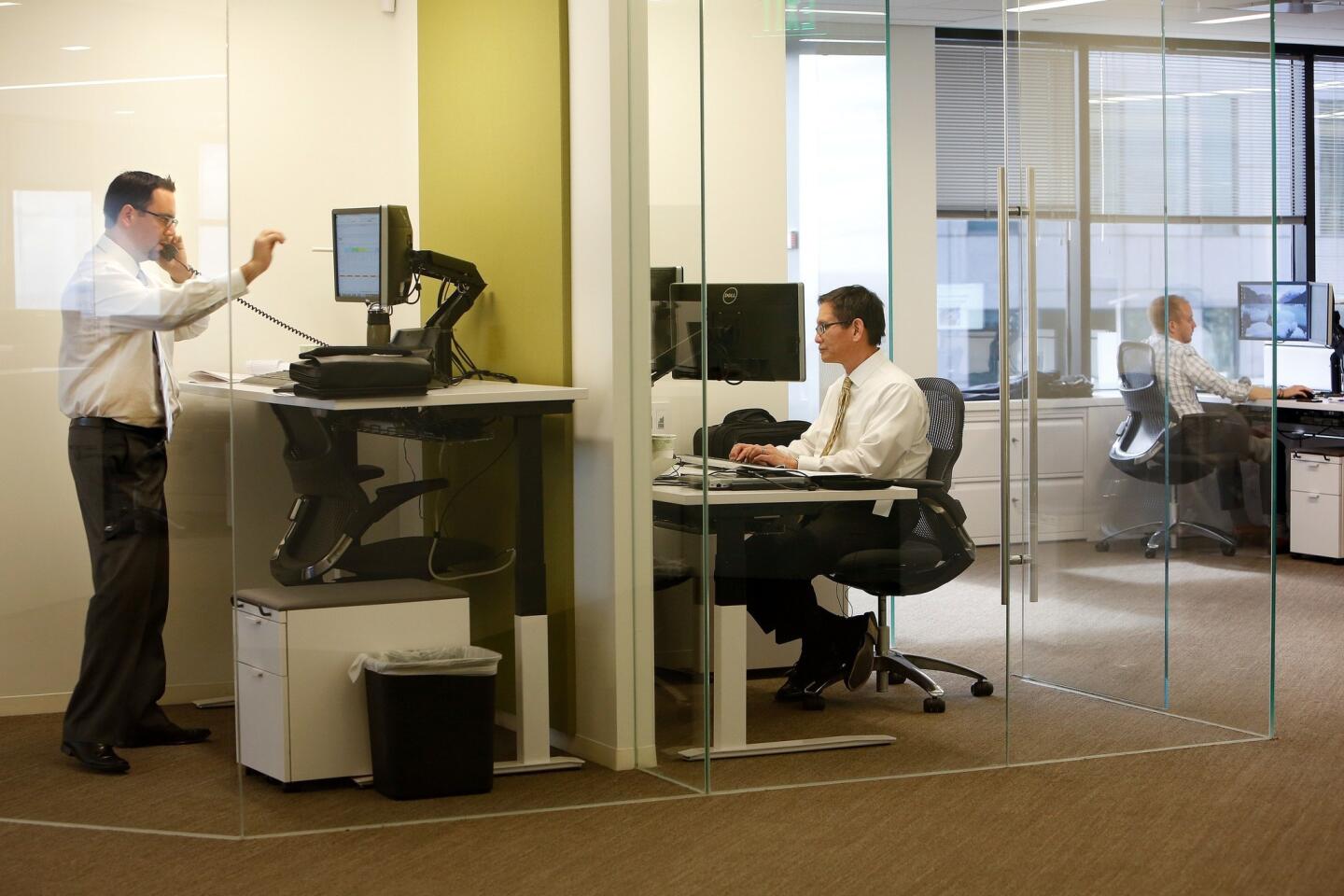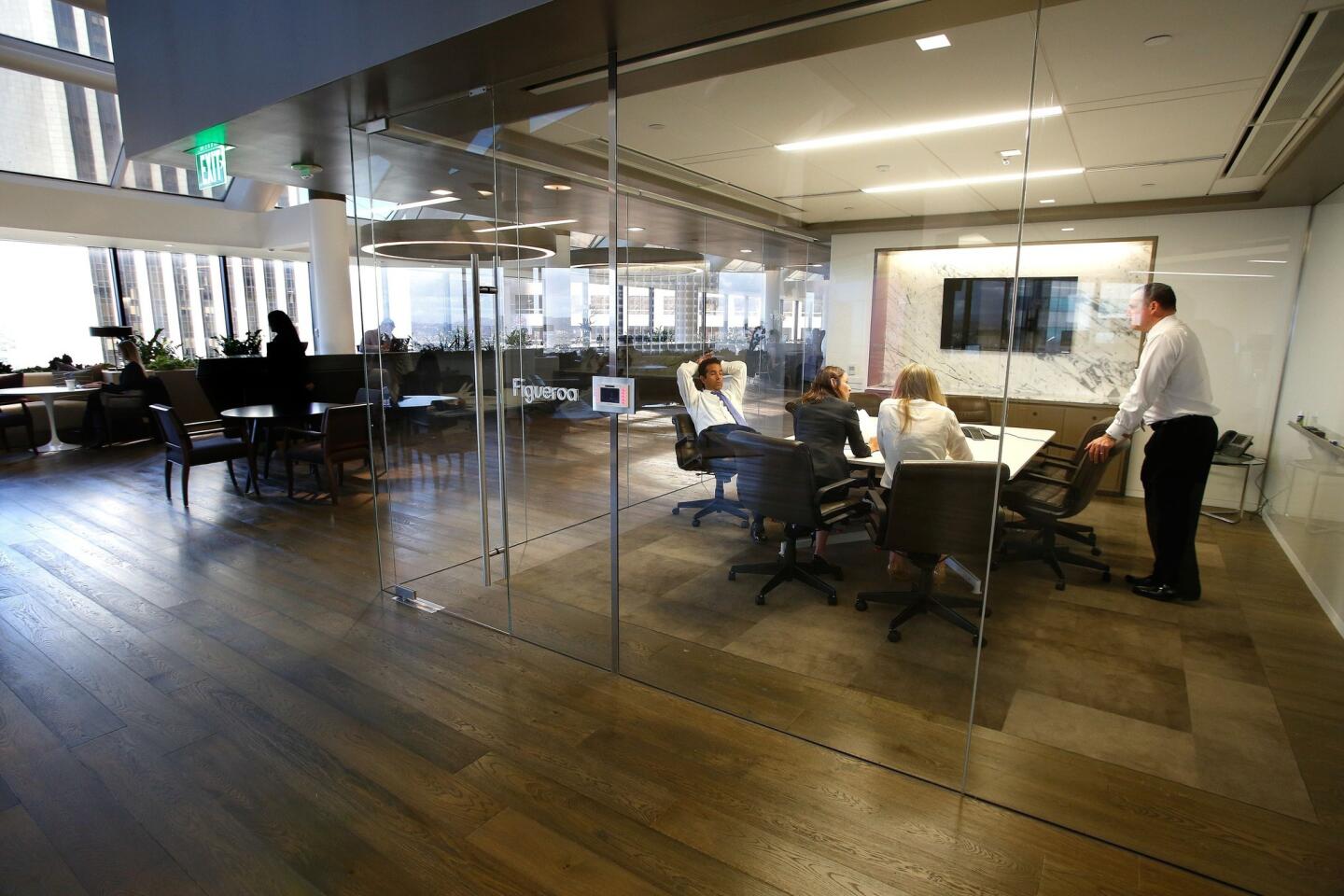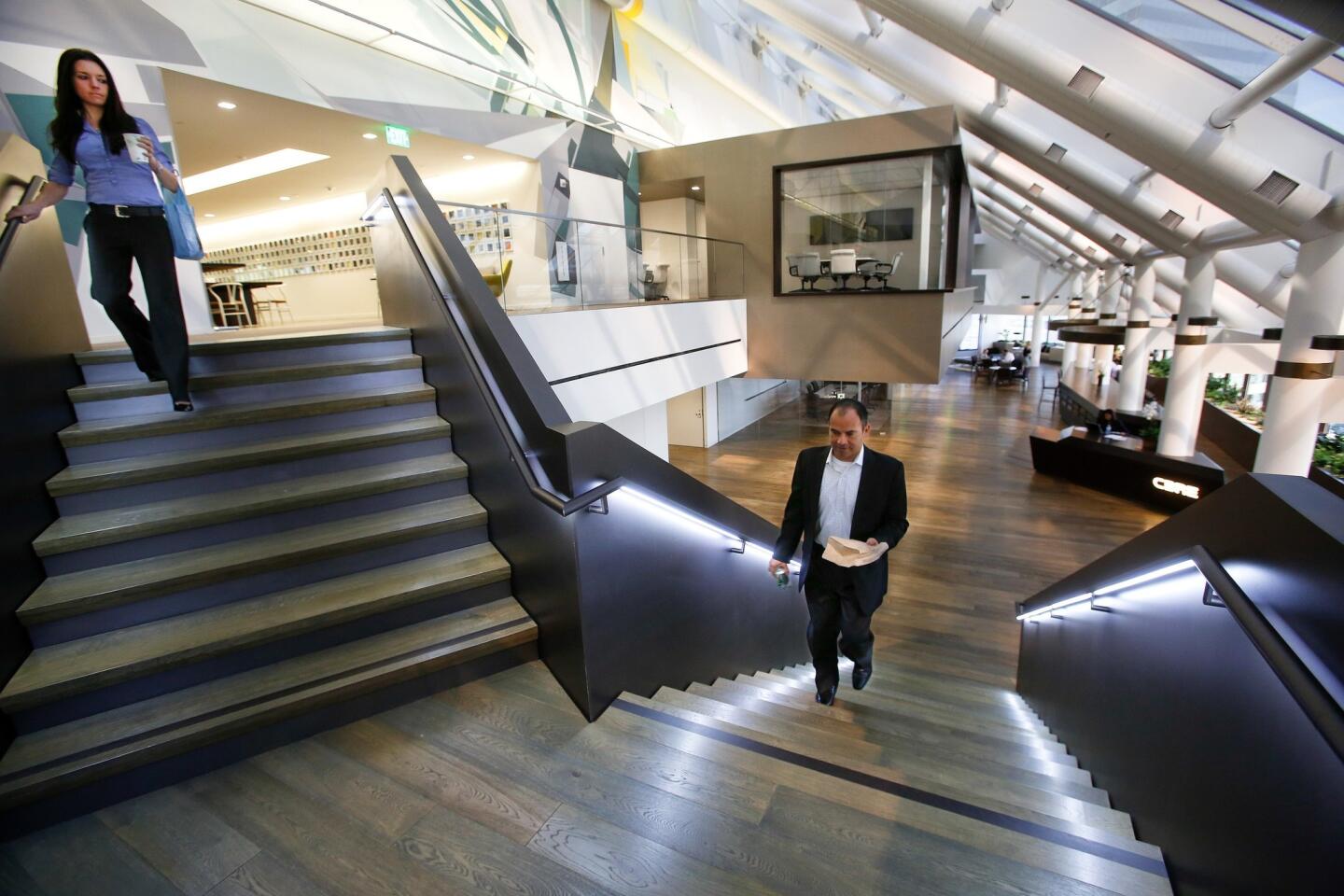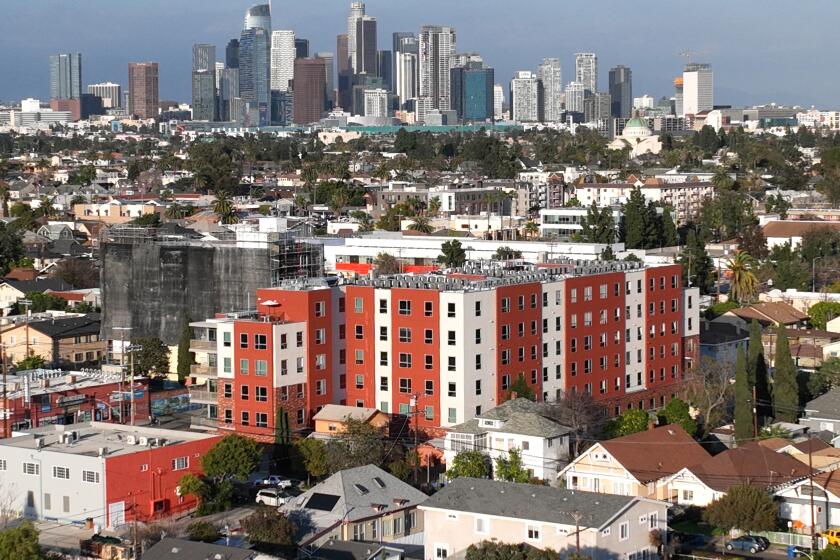The concept of an ‘untethered’ office takes root
- Share via
When he heard about a shake-up at company headquarters, Mark Sprague got a knot in the pit of his stomach.
It wasn’t his executive job that was at stake at the international real estate brokerage CBRE Group Inc. It was his spacious office of 11 years, his cherished file cabinets and his trophies. They all had to go.
Sprague and everyone else in the company’s 200-person office were given no choice by management. Everyone was to be part of an experiment to create the company’s first completely “untethered” office in the United States where employees roam freely.
In the airy complex on the top two floors of a Bunker Hill tower, there are no assigned desks or offices. Workers doing similar tasks can join their peers in a “neighborhood” or plop down on a modernist couch. Even Chief Executive Robert Sulentic books an office by the day and shed many of his possessions as part of the big move last month.
“No family pictures, no tokens, no nothing that is mine,” he said.
Improvements in technology have made framed photos outmoded. “I have lots of family pictures on my iPhone,” Sulentic said. “Five years ago we didn’t have that.”
When the boss leaves the office at night, he takes everything to an assigned locker or home in a briefcase.
The firm’s goal was to reduce rent costs by using its office space more efficiently and to create a template for other CBRE offices around the world.
If it worked, company officials figured, the downtown L.A. office would also be an example for other conservative white-collar firms pondering how to reorganize their workplaces to make them more efficient and appealing to young employees weaned on wireless technology.
PANORAMA: Inside CBRE’s L.A. office
Corporations have experimented for years with office-sharing concepts such as “hoteling,” where workers such as accountants who travel frequently “check in” to a desk when they are in the office. But examples of conventional white-collar offices where no one has an assigned desk are rare enough in the U.S. that CBRE had to look to its outposts in Europe for ideas.
After touring CBRE offices in Amsterdam, the company’s head of operations in Los Angeles and Orange counties, Lew Horne, decided to make what workplace consultants call a “free address” office in downtown L.A.
That meant everyone, including senior workers and newly hired assistants, would have to give up their private turf. As Horne was pushing the plan forward over the objections of Sprague and others, the company’s top management decided to take part in the experiment. Headquarters of the Fortune 500 firm were moved from the Westside to the downtown Los Angeles office.
Individual mobility and the office’s large common areas almost force employees to interact with one another and work together more effectively, Sulentic said. “People get used to communicating aggressively and openly with each other.”
PANORAMA: Inside CBRE’s L.A. office
The office makeover was overseen by Laura O’Brien, head of the company’s Workplace Strategies Group. One of her challenges was getting people ready to move by making them scan paper records into a computer or toss them straight into a recycling bin.
“We threw out 900,000 pieces of paper,” she estimated. Each employee is now supposed to have no more than one file drawer for storing paper documents.
Desktop computers were replaced with laptops that can be stored in lockers in the new office. Upon arriving, employees collect their telephone headsets, laptops and key files. They then head to one of 10 “neighborhoods” where employees doing similar tasks such as legal work or property management cluster. Or they can set up in the heart of the office near the front door that looks like a cross between an upscale hotel lobby and a coffee bar.
Workstations have telephones, keyboards and monitors that employees plug into, and they can sit, stand or even walk on a treadmill while they work. There are media-equipped conference rooms for meetings and small booths for making private phone calls.
“More choice makes the office more energetic,” O’Brien said.
The company provides healthful snacks and numerous “hydration stations” with filtered water. To help workers stay alert, CBRE pumps extra fresh air into the heating and air conditioning system and electronically adjusts the interior lighting to make it more in tune with sunlight streaming through the windows.
Because everyone starts anew each morning, a concierge team cleans all the desks each night, finishing with a wipe of a germ-killing electronic wand. The team will also stow the gear of an employee who perhaps intended to return from an outside meeting but didn’t make it back in time to put his property in his locker as he is supposed to do.
It cost 15% more per square foot to build the free-address office than a conventional CBRE office, O’Brien said, mostly in additional technology. But by reducing the overall size of its downtown office, the company should shave 30% off its projected rent and office capital expenditures.
One of CBRE’s goals with the new office, designed by architecture firm Gensler, was to break ground for clients by testing new ways of using space. One client who has been making workplace changes is Robert Domingues, chief operating officer of international labor law firm Littler Mendelson.
CBRE’s new setup is more ambitious than the law firm’s offices, but “We have started to evolve,” Domingues said. Littler offices are now being made a uniform size, and some employees who travel frequently are sharing offices.
Many lawyers, especially young ones, expect to be able to work remotely much of the time, Domingues said. The shifts in how lawyers use office space have enabled the firm to hold down its real estate costs even as it grows, he said.
Putting more people into less space is a widespread trend in corporate America, said Peter Miscovich, head of workplace innovation at brokerage Jones Lang LaSalle. “It’s a cost-avoidance strategy,” he said.
The challenge is to not just wedge workers more tightly together but to make the office someplace workers really want to be when they have the option to work at home or elsewhere.
“Why should I come in, unless you give me tremendous technology, great amenities, environmental quality and views?” he said.
Free-address offices with choice amenities have been incubating in the technology and start-up world, Miscovich said, but their adoption by a button-down firm such as CBRE signals that “the beginning of the workplace revolution has finally arrived,” he said.
PANORAMA: Inside CBRE’s L.A. office
He predicts more companies will adopt such designs as younger workers advance in their careers. “Millennials, who are digital natives, expect to work this way,” he said.
Older Generation X and baby boom workers may have to adapt to new workplace environments whether they want to or not.
CBRE’s Sprague, who gave up his cherished office, said he is making progress. He stakes out the same office every day and hasn’t roamed, but his fear that he would feel adrift hasn’t come true, he said. Sprague finds he gets more work done because he doesn’t want to pack in-box documents back into his locker at night.
He has also adjusted to being thrust into a more public space.
“I thought the place would feel impersonal,” he said. “It’s almost more personal, in a different way. It really does have a sense of community.”
Twitter: @rogervincent
More to Read
Sign up for Essential California
The most important California stories and recommendations in your inbox every morning.
You may occasionally receive promotional content from the Los Angeles Times.
